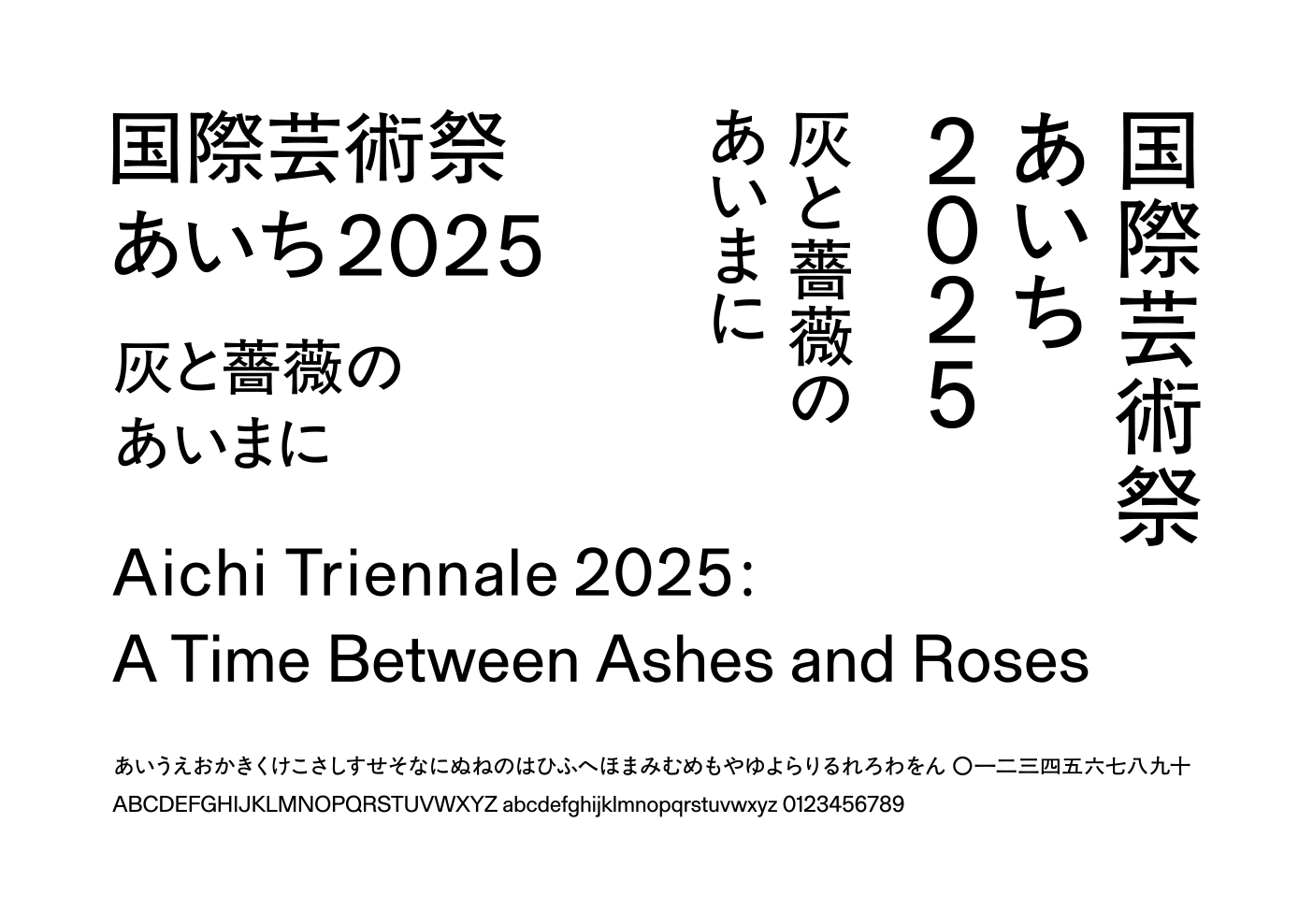Outline
Aichi Triennale
The Aichi Triennale is an urban international art festival, held every three years since 2010 across a wide region including the Aichi Arts Center and other city venues, and preparations are underway for Aichi Triennale 2025 to build on the achievements of the previous five iterations. The festival will span a wide range of fields, synthetically exhibiting performing arts and other form together with a contemporary art core, and make Aichi Prefecture a beacon of the artistic diversity.
Mission
- Contributing to the global development of culture and art by creating anddisseminating cutting-edge art
- Bringing culture and art into people’s daily lives by promoting and providingeducation on contemporary art
- Enhancing the attractiveness of the region by vitalizing culture and art activities
Highlights
Contemplating the World to Come Between Ashes and Roses
The theme of this edition of the Aichi Triennale, A Time Between Ashes and Roses, is taken from a verse by Adonis, a poet representing the contemporary Arab world. Witnessing the devastation of war, Adonis lamented the environmental destruction left in its wake; yet he was also conscious of the hope that lay beyond the ruins. In today’s world, serious problems have emerged in the relationship between humanity and the environment, with the divide between the two only growing deeper. By examining this complex, intertwined relationship from a geological timescale perspective, rather than through the humanity-centered concepts of nationhood, territory, and ethnicity, the Aichi Triennale explores ways for humans and the environment to trust, nurture, and complement each other. Moreover, instead of focusing on the dichotomous argument of ashes (eschatology) versus roses (optimism), the Triennale attempts to understand the world through the nuanced thinking that exists between these extremes.
The Diversifying and Expanding Creative Backgrounds of Artists
The 62 participating artists/groups who echo the theme of Aichi Triennale 2025 have diverse backgrounds. One distinctive feature of this edition is the strong representation of non-Western artists/groups, including participants from the Middle East, Africa, and Latin America, alongside Asian artists/groups, with twenty-six from Japan. The lineup also includes many who explore artistic expressions while reflecting on their social and cultural identities, such as artists with indigenous roots and those working far from home for various reasons. Their artistic expressions adopt remarkably diverse forms, each closely connected to various societal phenomena. Through diverse practices the artists unravel histories woven predominantly from Western-centric perspectives, thereby creating numerous opportunities to view and consider our increasingly complex world from fresh perspectives.
The Local Resources of Seto that Nurture Millennium-Long Ceramic Traditions
Seto City is a well-known ceramic capital blessed with abundant local resources, including porcelain clay, which are deeply intertwined with the daily lives of its residents. Shaped for over a thousand years using the area’s unique materials and resources, Seto’s ceramic industry continues as a source of local pride. In the past, ceramic production blackened the skies with ash, turned the rivers white and murky, and stripped the woodlands of villages; but these forms of environmental pollution and degradation also symbolized the city’s prosperity. How the industry developed opens up various avenues for exploring the relationship between humanity and the environment.
Outline
Theme
A Time Between Ashes and Roses
Period
September 13 (Saturday) to November 30 (Sunday), 2025 [79 days]
Main Venues
Artistic Director
Hoor Al Qasimi
(President and Director, Sharjah Art Foundation; President, International Biennial Association)
Organizer
Aichi Triennale Organizing Committee
(Chairperson Obayashi Takeo [Chairperson of the Board, Obayashi Corporation])
Programs
Contemporary Art
- Global contemporary art will be introduced through exhibitions and digital programs.
- Exhibitions will mainly take place at Aichi Arts Center which includes Aichi Prefectural Museum of Art, Aichi Prefectural Ceramic Museum, Seto City, and other locations throughout the prefecture.
Performing Arts
- Innovative and ground-breaking theater, and dance from around the world will be presented at Aichi Arts Center and other venues.
Learning
- Learning opportunities for a wide range of audiences.
Collaborative Programs
- Collaborative projects with a variety of organizations, including art universities within Aichi.
- Pop-up traveling exhibitions consist of works by Aichi Triennale 2025 participant artists at a number of sites within the prefecture.
Opening hours and Closing days
During the Aichi 2025 International Art Festival, the opening hours and closing days for each venue are as follows.
Aichi Arts Center
- Hours
- 10:00 to 18:00 (20:00 on Fridays)
* Last admission 30 min before closing time - Closed
- Closed on Mondays
(If Monday is a public holiday, the museum will be open and will close the following Tuesday.)
* On 11/3 (Mon), the museum will be open and closed on 11/4 (Tue)
* For exceptions, the museum will be open on the following dates; 9/16 (Tue), 11/24 (Mon), 11/25 (Tue)
Aichi Prefectural Ceramic Museum
- Hours
- 9:30 to 17:00 (until the end of September)
9:30 to 16:30 (from October onwards)
* Last admission 30 min before closing time - Closed
- Closed on Mondays
(If Monday is a public holiday, the museum will be open and will close the following Tuesday.)
* On 11/3 (Mon), the museum will be open and closed on 11/4 (Tue)
* For exceptions, the museum will be open on the following dates; 9/16 (Tue), 11/24 (Mon), 11/25 (Tue)
Seto City
- Hours
- 10:00 to 17:00
* Last admission 15 min before closing time
(Entry to Seto City Art Museum is possible until 30 minutes before closing time) - Closed
- Closed on Tuesday
(If Tuesday is a public holiday, the museum will be open and will close the following Wednesday.)
* For exceptions, the venues will be open on the following dates; 11/25 (Tue)
Theme/Concept
A Time Between Ashes and Roses
How can withered trees blossom?
A time between ashes and roses is coming
When everything shall be extinguished
When everything shall begin again*
After the Six Day War of 1967, the modernist poet Adonis lamented the environmental destruction of his surroundings, questioning the overwhelming presence of ashes in the Arab World. Ash, in Adonis’s poem, is not generated through general decomposition but as a result of human activity, in this case through senseless acts of violence, war and carnage. Visualising the War through its imprints in the environment, he signifies its legacy through a geologic and everlasting time view rather than immediate causes-and-effects or a present-day understanding of territoriality. In this way, it is not all gloom for Adonis, as after extinction comes blossoming.
This sentiment illustrates a common psychological concept: for renewal and rebirth, destruction and doom must precede it; for humanity to prevail, horror must be endured and take its course. Adonis grapples with feelings of hope and despair to envision a new future, a future freed from horrors tied to the present and the past. In his extrapolation of war from the national, ethnic, tribal, and the human-centred towards a collective environment, he foregrounds the multiplicitous expressions of war: the human-made war, the war on the planet, the war within ourselves, the war with others as well as the symbolism of the war on hierarchy, subjugation, oppression, famine, hunger, exploitation; the war on resources and energy; the war of possession and authorship; the war for hope, dreams and imagination.
The political context of Adonis’ writing of the poem, who experiences states of war and destruction as an observer and witness, is grounded in our experience of the present and expanded upon in this triennial. In A Time Between Ashes and Roses, I chose neither binary extreme of ashes nor roses as ultimate frontiers to conceive of the entangled relationships of the human-made environment. I question the boundary between them–inherited from Enlightenment knowledge cultures–and posit states, conditions and spectrums of human-environmental pathways. Rather than polarities, the triennial acknowledges extremes of our environmental condition, between war and hope, and explores decomposition possibilities of the two-way street conceived between humans and their environment.
In A Time Between Ashes and Roses, I question lines of inquiry separate from the canonical framing of the human-nature relationship: Are humans decomposing nature nor is nature decomposing humans? Are humans biomatter? Are there clear distinctions between the interior, psychological human, and the exterior, botanical world? Must we accept and critique canonical concepts–from the Anthropocene to Capitalocene to Plantationocene to Chthulucene–when addressing contemporary relationships between the human and the environment? Can art and exhibition-making approach the environment as a place of the unknown and to unearth new narratives and observe alternative perspectives?
For the sixth edition of the Aichi Triennale, I wanted to look at the relationships between human beings and the environment to unearth alternative land-based and indigenous assemblages. Prior to the mechanisation of agriculture and financialization of territory, communities from around the world stewarded nature and developed reciprocity with their environmental landscapes, conceiving of rights and protections of nature, as well as building paths of kinship, reliance, nutrition and replenishment with their surrounding habitats. This triennial hails this framework as part of contemporary artistic practices.
This curatorial approach builds on while also fostering a different imagination about contemporary imagination of the environment as a portmanteau of the human’s imprint on it, not with it. It is cognizant that human activities such as agro-farming, fossil-fuel extraction, deep-sea mining, exploitation of raw natural resources as well as growth-centred mentalities inherited from imperial structures, have created a system in which the human has no respite over the environment and developed dangerous structures of dependence. Additionally, our knowledge about the environment is human-centred, placing us as superior to nonhuman lifeforms, able to alter and modify it for our benefit.
Not only is the human a technocratic engineer flattening the environment into spaces for the appropriation of raw materials, it also re-enforces the inequalities which exist within human species. The environment we occupy today is orientalised, speciated, classified and modelled to benefit some communities over others and to enhance some communities’ quality of life over others. Current discourse of greening energy also seems reserved for those who are positioned in different hemispheres with many communities from around the world unable to benefit from critical environmental rehabilitative strategies. Thus, much of today’s human-environment practices reiterate racial, social and discriminatory knowledge and thinking.
Consequently, a large proportion of the globe lives and inherits centuries-long extractive colonial empires and finds their present condition calcified by multinational food, energy and agriculture corporations. Many of these communities are disproportionately affected by these human-environment relationships created by virtue of the western world’s colonial legacies whose current urban and civil structures are overwhelmingly responsible for the global changes we’re now seeing. It builds on the continuing genocide of indigenous people and their territories, the decades-long nuclear tests on colonised territories, legacies of violence and trauma in plantations and mines where forced labour has resulted in devastating loss of environmental life and indignity of people. This has changed and continues to change the geology of the planet in ways that will be felt beyond our lifespans, with severe implications for humanity’s survival.
While acknowledging the formidable narratives and research about the human-environment relationships of the present, in this triennial I aim to decenter both the apocalyptic and optimistic extremes we find ourselves compelled to run to. I find it is only through layering complexity in our dialogue about environmental justice can we face our responsibilities and realise our complicity. To avoid imposing a hierarchy or preference for one reading over the other, this triennial invites artists and collectives from all over the world to realise existing and unknown narratives about the environment in which we occur. Is nature resilient because of how it is tested, and endures death and destruction as imagined by Adonis? Or are the dystopian, apocalyptic cli-fi futures which are void of life, mechanised and made superficial, a truly lived reality?
Rooting the triennial in Aichi Prefecture, Japan’s own environmental imagination, between ashes and roses, will also be embedded in the exhibit. Aichi is a locus of ceramic production and Seto City is famous for the fabrication of Setomono. These local industries which work with the surrounding environment’s materials and resources, will feature in the artist commissions. Since these industries are a source of local pride, they support the triennial’s exploration for alternative models of human-environment relationship. As an example, in Aichi, historic photographs and archives which depict ashy black skies generated from the production of ceramics signified prosperity rather than pollution and destruction. Thus, what conceptions of technology, locally-based knowledge, imperial history, environmental imaginations come up when we decenter the universalist Anthropocenic critique? Do such local industries and heritage pave way for alternative and spectral thinking about the human-environment entanglement?
Additionally, various moments and instances of Japanese popular culture, its fiction, films and music will also be referenced, such as Nextworld by Osamu Tezuka. In the novel, the USA and USSR are competing with each other in the atomic bomb race–a history deeply intertwined with the modern making of Japan and its environmental condition–and accidentally creates a race of mutant animals known as Fumoon. They are gifted with psychic powers and intelligence beyond humans who formulate a strategy to evacuate hundreds of animals and a small group of people off planet Earth. The Fumoon, a byproduct of nature-human species come to save the day.
Resonating with the theme of this triennial as well as Adonis’s poem, Nextworld is a traversal between apocalypse and blossoming. Altogether, these references, the locality of the Aichi Prefecture, writers such as Adonis and Tezuka, as well as the participating artists, A Time Between Ashes and Roses is an triennial which shows that in adopting the spectral, limited and in between, assumed positionalities and hierarchies can come undone.
Aichi Triennale 2025, Artistic Director
Hoor Al Qasimi
- *Adonis, “An Introduction to the History of the Petty Kings,” A Time Between Ashes and Roses, 1970.
Curatorial Team
Artistic Director
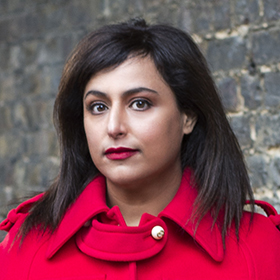
Hoor Al Qasimi
[President and Director of the Sharjah Art Foundation]SEBASTIAN BÖTTCHER
Hoor Al Qasimi, President and Director of Sharjah Art Foundation, is a curator who established the Foundation in 2009 as a catalyst and advocate for the arts, not only in Sharjah, UAE but also in the region and around the world. With a passion for supporting experimentation and innovation, she has continuously expanded the scope of the Foundation to include major international touring exhibitions; artist and curator residencies in visual art, film, and music; commissions and production grants for emerging artists; publications and publication grants; performance and film festivals; architectural research and restoration; and a wide range of educational programming for all age groups.
She co-curated Sharjah Biennial 6 (2003) and has remained Biennial Director since and was curator of Sharjah Biennial 15 (2023). She was also elected as President of the International Biennial Association in 2017, the President of The Africa Institute, and President and Director of the Sharjah Architecture Triennial. Previously, she was a board member for MoMA PS1, New York, and the UCCA Center for Contemporary Art, Beijing, etc.
Head of Curatorial
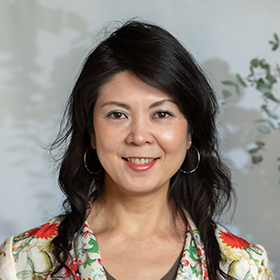
Iida Shihoko
[Independent Curator]ToLoLo studio
Iida Shihoko was born in Tokyo and is based in Nagoya, Japan. She worked as Curator at the Tokyo Opera City Art Gallery for 11 years, starting as Assistant Curator in 1998 when it was preparing for opening. From 2009 to 2011, Iida was a Visiting Curator of ACAPA, a research institute within the Queensland Art Gallery/Gallery of Modern Art in Brisbane, Australia. She stayed in Seoul as a 2011 International Fellowship Researcher, hosted by National Museum of Modern and Contemporary Art, Korea. Drawing from her interest in co-curation, contemporary art in Asia, and the relationship between society and art institutions, Iida has co-curated exhibitions in Seoul, multiple cities in Australia, New Delhi, Jakarta, and Milan. Additionally, she worked on the 15th Asian Art Biennale Bangladesh 2012, Aichi Triennale 2013, and Sapporo International Art Festival 2014 as Curator, also served as Chief Curator (Head of Curatorial Team) of Aichi Triennale 2019 and 2022. From 2014 to 2018, she was Associate Professor at the Tokyo University of the Arts. Iida is a member of CIMAM, IBA, and AICA.
Curator (Contemporary Art)
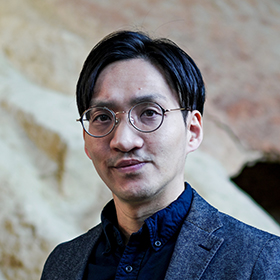
Irizawa Masaaki
[Curator, Aichi Prefectural Ceramic Museum]Born in Osaka, Japan. Irizawa Masaaki completed an MFA at Kyoto City University of Arts. After a curatorial internship at the National Museum of Modern Art, Kyoto, from 2015 to 2017 he served as a curator at the Asahi Group (formerly Asahi Breweries) Oyamazaki Villa Museum of Art. He has held his current position since 2018. He specializes in the history of modern and contemporary Japanese ceramics. He plans and curates exhibitions that handle ceramics not only as a form of artistic expression, but also from an industrial perspective. In recent years he has been responsible for mounting exhibitions including The Ceramic Sculpture of Shindo Tsuji (2020), THE NOSTALGIC JAPAN 1950s-70s: the Modern Tableware and the Design Drawings (2022), Modern Thoughts on Pottery: Inside⇄Outside (2022). He also participated in Dividing Line-Connecting Line (2013, in collaboration with Kawai Yuki), a curatorial grant project of the Nishieda Foundation.
Curator (Performing Arts)
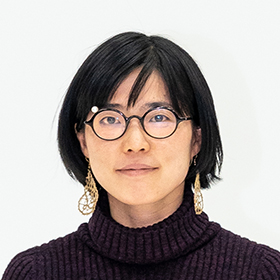
Nakamura Akane
[Performing Arts Producer]Takuya Matsumi
Born in Tokyo, Japan. Nakamura Akane has been involved in the performing arts since her time as a student at Nihon University College of Art. She served as program director at ST Spot Yokohama from 2004 to 2008. In 2006 she was involved in the founding of precog Co., Ltd. in 2006, and she has been its representative director (CEO) since 2008. As a grantee of the Asian Cultural Council (ACC), she lived in Bangkok and New York from 2016 to 2018. Along with producing contemporary theatrical and dance works for artists and companies inside and outside of Japan, Nakamura works on site-specific festivals and interdisciplinary training programs, and in a project that operates a platform for distributing video content in barrier-free and multilingual formats. She has served as producer for overseas tours and co-productions spanning seventy cities in thirty countries. From 2012 to 2014 she served as performing arts program director for Kunisaki Art Project and Kunisaki Art Festival (sponsored by Kunisaki Art Festival Executive Committee); in 2019 she served as associate director and deputy secretary general of the True Colors Festival celebration of diversity in the arts (sponsored by The Nippon Foundation); and in 2020 she served as executive producer for “THEATRE for ALL,” an online theater that focuses on accessibility. She was awarded the Minister of Education, Culture, Sports, Science and Technology’s FY2021 Encouragement Prize for New Artists in development of the arts.
Curator (Learning)
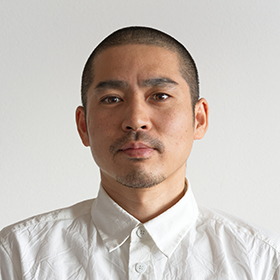
Tsuji Takuma
[Architect]goitami
Born in Shizuoka, Japan. After graduating from the Yokohama Graduate School of Architecture (Y-GSA), Tsuji teamed up with Hashimoto Takeshi and Yada Toru to form the 403architecture [dajiba] architectural collective in 2011. As 403, the collective won the 30th Yoshioka Award for The Ceiling of Tomitsuka in 2014; participated in the Japan Pavilion exhibition that won a special mention at the 15th International Architecture Exhibition, La Biennale di Venezia in 2016; and it has shown its work at numerous exhibitions inside and outside of Japan, including Aichi Triennale 2016. Since establishing tsujitakuma and projects LLC as his own office in 2017, in parallel with 403, Tsuji has focused on the theme of intermittent, yet fluid, transitions in buildings and spaces. In 2019 he served as a lecturer for the Aichi Triennale’s art university collaboration project and from 2020 to the present he served as a specially appointed lecturer on Community Area Design at Nagoya Zokei University.
Curatorial Adviser (Contemporary Art)
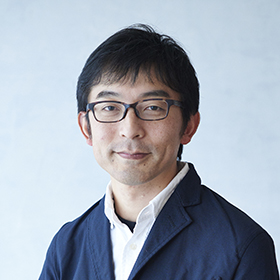
Ishikura Toshiaki
[Anthropologist/Associate Professor, Department of Arts & Roots, Akita University of Art]Ishikura has conducted field research in places including Sikkim, Darjeeling, Nepal, and northeastern Japan, researched comparative mythology of the Pacific Rim and multispecies artistic anthropology. He collaborates with artists and cooperates in the planning and curation of exhibitions. Before assuming his current position, he served as an assistant at the Institute for Anthropology of Art and Design, Tama Art University and then as a researcher at the Institute pour la Science Sauvage, Meiji University. In 2019, he participated in the Cosmo-Eggs exhibition at the Japanese Pavilion for the 58th Venice Biennale. He has co-authored books including Lexicon: Contemporary Anthropology and More Than Human: Multispecies Anthropology and Environmental Humanities (both in Japanese, Ibunsha).
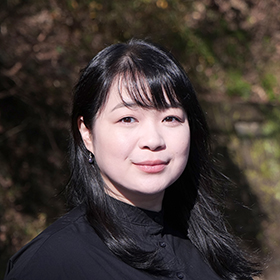
Cho Sunhye
[Associate Curator, Mori Art Museum]Born in Tokyo, Japan. After working as an exhibition assistant and coordinator in Japan and elsewhere in East Asia, Cho was appointed assistant curator for Aichi Triennale 2016. She has served as a curator the Fukuoka Asian Art Museum from 2016 to 2024, before assuming her current position. She specializing in Asian contemporary art. In recent years she has been conducting research on art history and visual art by pan-Asian immigrants. At FAAM, she has curated exhibitions including Waters in Asian Art (2023), Message—50 Years of Women Artists in Asia (2020), Fukuoka Asian Art Museum 20th Anniversary Exhibition: Journey through Asian Art (2019), and LGBTQ and Social Diversity in Asian Art (2019).
- Project Manager
Soeda Kazuho, Serizawa Namiki
- Contemporary Art
- Architect
Kurimoto Shinichi(Kurimoto Design Studio), Maruta Tomoaki(Tomoaki Maruta Architects), Mitani Yuki(nanometer architecture), Yamagishi Aya(CYCLE ARCHITECTS)
- Technical Director
Nishi Tsubasa, Yamada Shimpei(AOZORA, LTD.)
- Project Officer
Kitazawa Hiromi
- Coordinator
Ohno Kohki, Oda Ayuko, Kataoka Asami, Kiyosawa Satoko, Sakata Mioko*, Suzuki Kazue, Takehira Hiroki, Tsunekawa Akemi, Hanada Yuuki(works also as PA Coordinator), Hayashi Ikumasa, Hijikata Dai, Honda Yaari
- Performing Arts
- Technical Director
Moriyama Marie
- Coordinator
Kanda Tamami, Nozaki Miki, Hayashi Machiko, Hayashi Mei, Kamijo Keiko, Kato Natsumi, Shinoda Shiori, Tazawa Mizuki, Ouki Tamiko, Konaka Yasue, Saito Yuri, Sakiyama Takafumi
- Learning
- Team Members
Asano Kakeru, Kuroda Natsuki, Noda Tomoko, Murakami Satoshi
- Coordinator
Hiruma Yurie
- Communicator
Matsumura Atsuko
- Facilitator
Koide Kazuha, Kobayashi Reina
- Interactive viewing supervisor
Aida Daiya, Ohba Haruki
- Catalogue
- Editor
Masuda Chie
* until 31st March, 2025
Key Visual
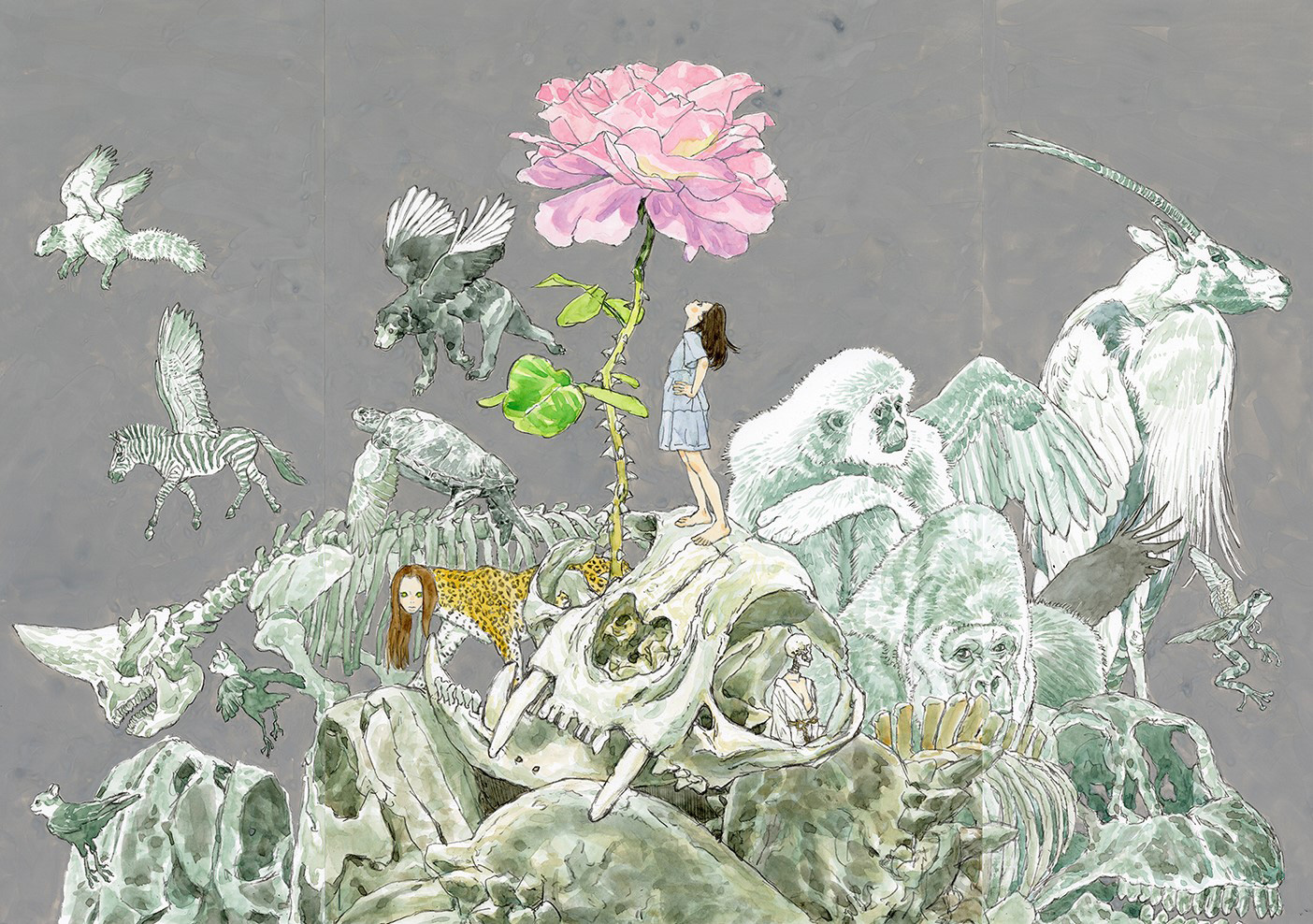
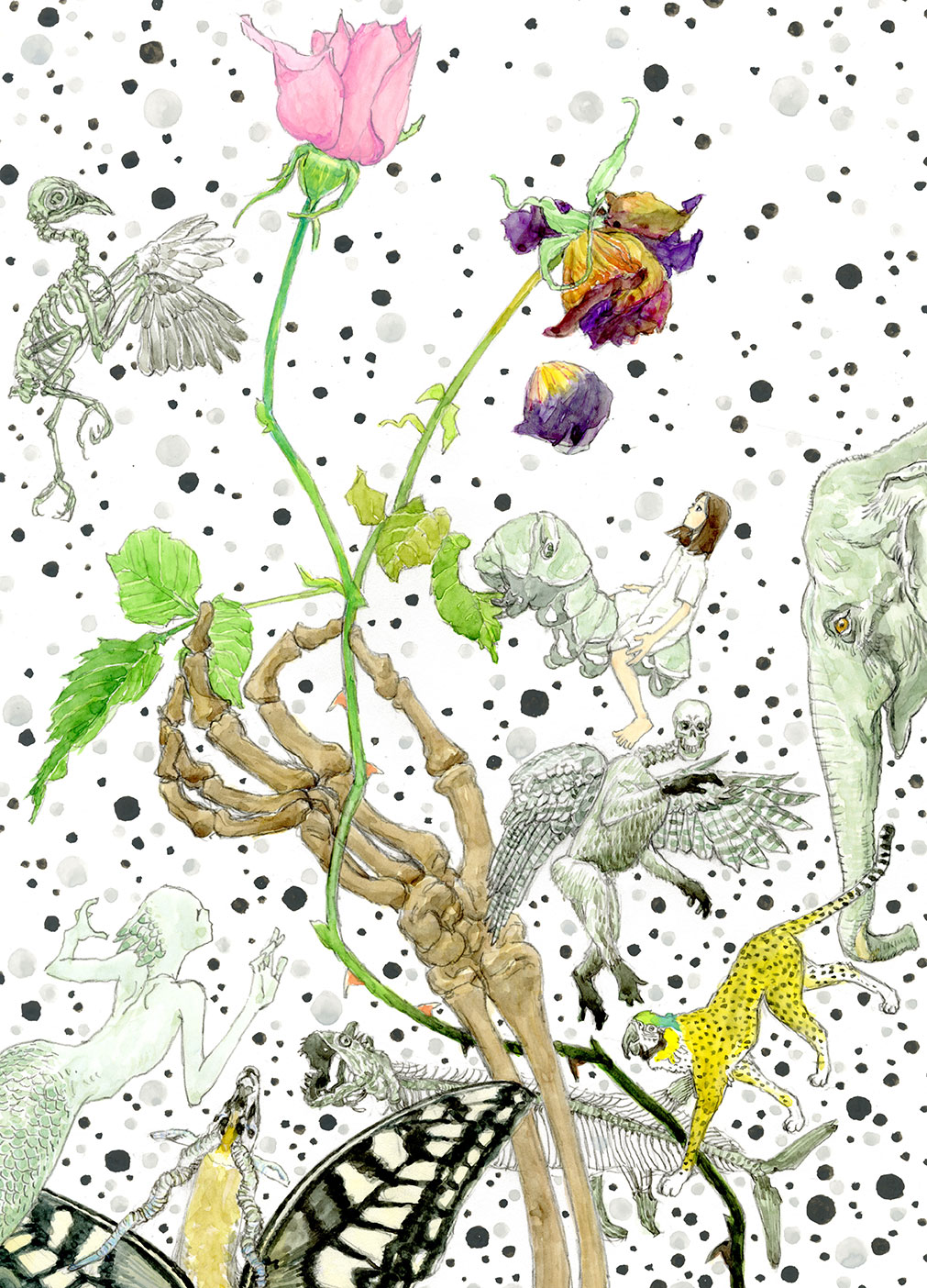
My first thought was “Where do roses blossom?”
Are ashes the result of outrageous destruction and death?
If that’s the case, perhaps roses bloom in the land of the dead.
So I drew ghosts, as the inhabitants of the land of the dead.
While I was drawing, I felt that those ghosts, which should be dead, were coming to life a little.
What I was thinking of as “the land of the dead” may well be “the land of those who have yet to be born.”
That’s what this illustration is about.
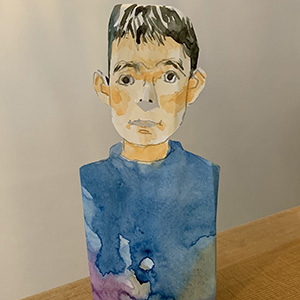
Igarashi Daisuke
Design
